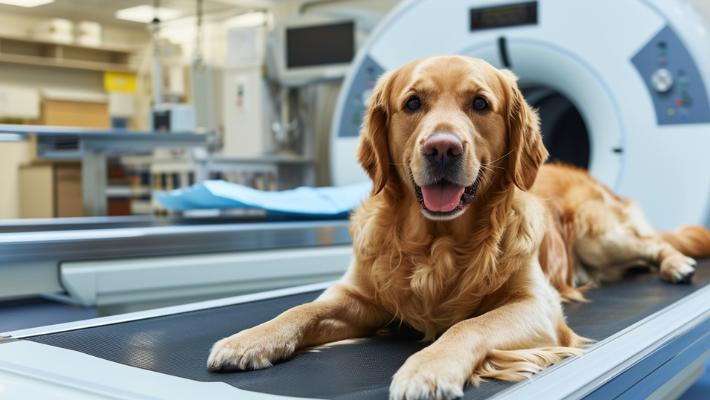Osteosarcoma in Dogs: Signs, Diagnosis, and Treatment Options


If you’re a dog owner, you know how important it is to keep your furry friend healthy and happy. However, sometimes, despite our best efforts, our beloved pets can develop serious health conditions.
One such condition is osteosarcoma, a type of bone cancer that commonly affects dogs. In this guide, we will delve into osteosarcoma in dogs. We’ll break down the risk factors, symptoms to watch for, how vets diagnose it, and the different treatment options available. So lets get started!
What Is Osteosarcoma?
Osteosarcoma is a malignant tumor that originates in the bone cells of dogs. It is the most common type of bone cancer found in canines, accounting for approximately 85% of all cases. Osteosarcoma typically affects larger breeds, such as Great Danes, Rottweilers, and German Shepherds, although it can occur in any breed. Dog Breeds with a higher risk of osteosarcoma include:

- Doberman Pinschers
- Greyhounds
- Irish Wolfhounds
- Saint Bernards
- Giant Schnauzers
- Golden Retrievers
- Boxer Dogs
- Labrador Retrievers
This cancer usually develops in the long bones, such as the limbs, but it can also affect other bones in the body. The exact cause of osteosarcoma in dogs is still unknown, but several risk factors have been identified.
Large and giant breeds are more susceptible to developing this type of cancer, as are middle-aged to older dogs. Additionally, certain genetic factors and previous bone injuries may increase the likelihood of osteosarcoma in dogs.
Causes And Risk Factors Of Osteosarcoma In Dogs
While the exact cause of osteosarcoma remains a mystery, there are several factors that have been associated with an increased risk of developing this disease in dogs. One of the primary risk factors is breed.
Large and giant breeds, such as Great Danes, Irish Wolfhounds, and Saint Bernards, are more prone to developing osteosarcoma compared to smaller breeds. This is thought to be due to their rapid growth rate and the increased stress on their bones.

Age is another important risk factor. Osteosarcoma predominantly affects middle-aged to older dogs, with the peak incidence occurring around 7-8 years of age. However, it can occur in younger dogs as well. Gender does not appear to play a significant role in the development of osteosarcoma, as both male and female dogs are equally affected.
Genetics may also play a role in the development of osteosarcoma. Certain breeds, such as Rottweilers and Greyhounds, have a higher incidence of the disease, suggesting a genetic predisposition. Additionally, previous bone injuries, such as fractures or orthopedic surgeries, have been associated with an increased risk of osteosarcoma.
Here are some other risk factors:
- Rapid growth: Rapid growth spurts, especially in large and giant breed puppies, may be a risk factor.
- Diet: There is no definitive evidence that diet causes osteosarcoma, but some studies suggest that a diet high in protein may increase the risk.
- Neutering status: As mentioned earlier, neutering a large or giant breed dog before one year of age may increase the risk.
Signs And Symptoms Of Osteosarcoma In Dogs
Recognizing the signs and symptoms of osteosarcoma in dogs is crucial for early detection and treatment. Here are some of the most common signs and symptoms to watch for:

- Lameness: This is often the first sign, especially for tumors in the limbs. The lameness may not be constant and could come and go at first.
- Swelling: You might notice swelling around the affected bone, particularly in the ribs, spine, legs, or jaw.
- Pain: Osteosarcoma is a painful condition. Your dog might be reluctant to bear weight on the affected limb, whimper when touched or seem generally uncomfortable.
- Loss of appetite: This can be a sign of pain or malaise caused by the cancer.
- Lethargy: Your dog might seem tired or withdrawn and have less energy for activities they used to enjoy.
- Mass or lump: In some cases, you might be able to feel a firm mass on your dog’s body.
- Difficulty eating: If the tumor is in the jaw, your dog might have trouble chewing or eating.
- Neurological signs: For tumors in the skull or spine, your dog might experience seizures, weakness, or a wobbly gait.
- Breathing difficulties: If the tumor is in the ribs, your dog might have trouble breathing.
- Discharge from the nostrils: This can occur with tumors in the skull or nasal passages.
The most common sign of osteosarcoma is lameness or limping, which is often intermittent at first but progressively worsens over time. The affected limb may also appear swollen and painful to the touch. Dogs may exhibit a decreased interest in physical activities and may become lethargic or reluctant to move.
In some cases, the tumor may become visible as a lump or swelling on the affected limb. This is more commonly observed in cases where the tumor is located near the surface. However, in many cases, the tumor is located deep within the bone, making it difficult to detect without diagnostic imaging. Other less specific symptoms of osteosarcoma may include weight loss, loss of appetite, and difficulty breathing if the tumor has spread to the lungs.
Diagnosing Osteosarcoma In Dogs
Diagnosing osteosarcoma in dogs requires a combination of clinical evaluation, diagnostic imaging, and histopathology. Your veterinarian will first conduct a thorough physical examination of your dog, assessing their gait, range of motion, and any visible abnormalities. They may also perform blood tests to evaluate your dog’s overall health and rule out other potential causes of lameness.

To confirm the presence of a bone tumor, diagnostic imaging is crucial. X-rays are the most commonly used imaging technique and can provide valuable information about the location, size, and appearance of the tumor. While X-rays alone can’t definitively diagnose osteosarcoma, they can reveal abnormalities in the bone structure that suggest the presence of cancer. These abnormalities might include:
- Lytic lesions: Areas where bone appears “moth-eaten” due to bone loss.
- Productive bone growth: Areas of abnormal and excessive bone formation.
- “Sunburst” pattern: A combination of abnormal bone changes resembling a halo or crown around the affected area.
Depending on the initial findings, your veterinarian might recommend additional imaging tests to get a clearer picture of the tumor and potential spread. These could include:
- CT scan: Provides a more detailed 3D image of the bones and surrounding tissues, helping assess tumor size, location, and potential involvement of nearby structures.
- MRI scan: Can be particularly helpful in evaluating tumors near the spine or brain.
However, the definitive diagnosis of osteosarcoma can only be made through histopathology. This involves obtaining a biopsy of the tumor, either through a fine needle aspirate or a surgical biopsy.
The collected tissue sample is then sent to a veterinary pathologist, who will examine it under a microscope to determine if it is indeed osteosarcoma. This step is crucial as it helps guide treatment decisions and provides valuable prognostic information.
Osteosarcoma can also spread to the lungs, so sometimes vets recommend chest X-rays to check for metastasis (cancer spread) even if your dog isn’t showing respiratory signs.
Treatment Options For Osteosarcoma In Dogs
The treatment options for osteosarcoma in dogs depend on several factors, including the location and size of the tumor, the extent of metastasis (spread), and the overall health of the dog. The primary goal of treatment is to alleviate pain, slow down the progression of the disease, and improve the dog’s quality of life.

The most common treatment approach for osteosarcoma is a combination of surgery and chemotherapy. Here’s a breakdown of the most common treatment options:
Surgery
There are two ways to treat osteosarcoma through surgery. These are as follows:
- Amputation: The standard surgical procedure involves amputating the affected limb, followed by a course of chemotherapy to target any remaining cancer cells. This approach not only removes the source of pain but also helps control the spread of the disease. Most dogs adapt remarkably well to life on three legs.
- Limb-Sparing Surgery: In some cases, depending on the tumor location and size, limb-sparing surgery might be an option. This involves removing the tumor and reconstructing the limb using implants or bone grafts. However, this is not suitable for all dogs and carries a higher risk of complications compared to amputation.
Chemotherapy
Chemotherapy plays a crucial role in the treatment of osteosarcoma. It is almost always recommended after surgery, even if there are no signs of metastasis. This is because chemo helps destroy any remaining cancer cells in other parts of the body.

The specific chemotherapy protocol may vary depending on the individual dog and the stage of the disease. Commonly used drugs include doxorubicin and carboplatin, which have shown efficacy in extending the survival time and improving the quality of life for dogs with osteosarcoma.
It’s crucial to discuss all the options thoroughly with your veterinarian to determine the most appropriate course of action for your furry friend.
What Is The Prognosis And Life Expectancy For Dogs With Osteosarcoma
The prognosis for dogs with osteosarcoma varies depending on several factors, including the stage of the disease, the presence of metastasis, and the overall health of the dog. Unfortunately, osteosarcoma is an aggressive cancer, and without treatment, the disease progresses rapidly, leading to severe pain and a decreased quality of life.

With appropriate treatment, the median survival time for dogs with osteosarcoma is around 10-12 months. However, some dogs may live for several years with proper management and supportive care. It’s important to remember that every case is unique, and individual factors can greatly influence the prognosis. Regular follow-up visits with your veterinarian are crucial for monitoring the dog’s progress and adjusting the treatment plan if necessary.
Managing Pain And Providing Supportive Care For Dogs With Osteosarcoma
Pain management is an essential aspect of caring for dogs with osteosarcoma. The disease can cause significant discomfort, and relieving pain is crucial for maintaining the dog’s quality of life. Your veterinarian may prescribe pain medications, such as nonsteroidal anti-inflammatory drugs (NSAIDs), opioids, or other analgesics, to alleviate pain and improve mobility.

In addition to pain management, providing supportive care is essential for dogs with osteosarcoma. This includes maintaining a balanced diet to ensure proper nutrition and weight management. Regular exercise is also important, as it helps maintain muscle mass and joint mobility. Physical therapy and rehabilitation techniques, such as hydrotherapy and therapeutic exercises, may be beneficial in improving the dog’s overall well-being.
Emotional support is equally important, both for the dog and the owner. Dealing with a diagnosis of osteosarcoma can be emotionally challenging, and seeking support from friends, family, or support groups can make a significant difference. Remember to provide a loving and comfortable environment for your dog, showering them with affection and ensuring they feel safe and secure.
Preventing Osteosarcoma In Dogs
While it is not possible to completely prevent osteosarcoma in dogs, there are steps you can take to minimize the risk. Early spaying or neutering of dogs may reduce the risk of certain types of cancer, including osteosarcoma. Additionally, providing a balanced diet and maintaining a healthy weight can contribute to overall health and potentially reduce the risk of developing certain cancers.

Regular veterinary check-ups are crucial for early detection and treatment of any health issues, including osteosarcoma. By monitoring your dog’s health and addressing any concerns promptly, you can ensure that potential problems are identified and managed in a timely manner. Remember to consult your veterinarian if you notice any unusual symptoms or changes in your dog’s behavior.
Wrapping Up
Osteosarcoma is a devastating disease that affects many dogs, but with early detection, appropriate treatment, and supportive care, it is possible to provide a good quality of life for your furry friend.
By understanding the causes, recognizing the signs and symptoms, and seeking prompt veterinary care, you can make a significant difference in the outcome for your dog. Remember, you are not alone, and there are resources and support available to help you navigate through this challenging journey.
Your veterinarian is your biggest source of guidance and support, so do not forget to consult them if you have any concerns or questions about osteosarcoma in dogs. Lastly, stay informed, stay proactive, and, most importantly, cherish the precious moments you have with your beloved canine companion.








All Comments
6 June, 2024
Your ability to articulate complex concepts clearly showcases your strong grasp of the subject matter. I am eager to delve into more of your insightful content. Thank you for providing such a high-quality resource.
Reply
17 June, 2024
Thank you for offering your expertise and providing us with such enlightening and comprehensive content.
Reply
18 June, 2024
Somebody essentially help to make significantly articles I'd state. This is the first time I frequented your web page and up to now? I surprised with the research you made to make this actual post incredible. Fantastic job!
Reply